Table of Contents
Asiatic Black Bear
Ursus thibetanus (G.[Baron] Cuvier, 1823)
Photo by Guerin Nicolas
(Permission obtained under GNU Free Documentation License)
1. Introduction
Ursus thibetanus or more commonly known as the Asiatic black bear is one of the eight bear species in the world along with the American black bears, pandas, sloths bears, spectacled bears and sun bears. As charismatic as they are, playing important ecological roles such as being seed dispersers, its numbers are dwindling due to a myriad of reasons (see: Threats). This species page is thus aimed at animal lovers and conservationists or simply people who are genuinely concerned for the bears and interested in knowing more.
1.1. Nomenclature
Binomial name: Ursus thibetanus (G.[Baron] Cuvier, 1823)
Synonym: Selenarctos thibetanus (Blandford, 1888)
Vernacular names: A variety of names in different languages are given, including but not limited to: Asiatic Black Bear, Asian Black Bear, Himalayan Black Bear, Ours du Tibet, Ours à collier, Ours de l'Himalaya, Ours noir d'Asie in Fench and Oso de collar, Oso Negro de Asia in Spanish
The variety in names can be attributed to the wide ranging distribution of U.thibetanus (see Distribution) with fossil records dating back to as far as Germany and France. It also occupies almost all countries in Southeast Asia with the exception of Malaysia [1].
2. Description
Asiatic black bears are black and possess a light brown muzzle bearing a resemblance to their more known American relative (the American black bear,Ursus americanus). It has a distinct white or cream coloured V-shaped patch on the chest hence they are also known as the moon bear (Fig 1). Its ears are bell-shaped and tend to be longer than those of other bears
Fig 1. Asiatic black bear Photo by Jagdeep Rajput
(Source: www.arkive.org)
Males tend to be bigger than females in which the males typically weigh 110 -150 kg and females weigh about 65 -90kg. The head and body measure 120 to 180cm in length while the tail is an additional 6.5ccm to 10.6cm. Its legs are thick and strong and its paws, broad (Fig 2). The paws are primarily used for climbing and digging [2].
.
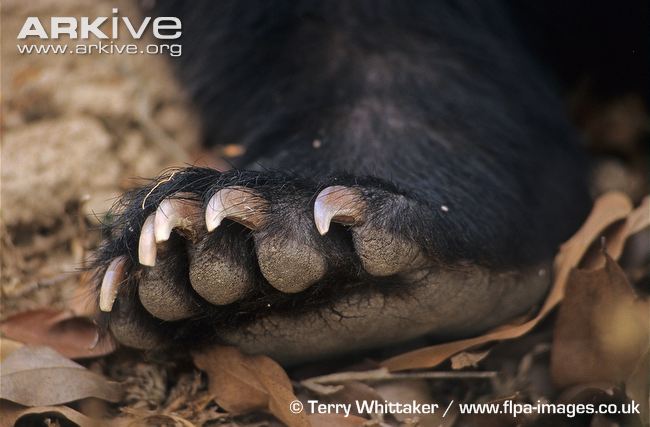
Fig 2. Broad paws of an Asiatic black bear. Photo by Terry Whittaker
Source: www.arkive.org)
2.1 Diagnosis (comparison with sub-species)
There are 7 recognized subspecies of U.thibetanus.
Table 1. Comparison of the 7 subspecies of U.thibetanus
|| Subspecies
| U.thibentanus thibetanus (Cuvier, 1823) |
//U.thibetanus formosanus// (Swinhoe, 1864) |
U.thibetanus gedrosianus (Blandford, 1877) |
U.thibetanus japonicas (Schlegel, 1857) |
U.thibetanus laniger (Pocock, 1932) |
U.thibetanus ussuricus (Heude, 1901) |
U.thibetanus mupinensis (Heude, 1901) |
|
| Length |
120-180cm |
120-190cm |
140-190cm |
110-140cm |
140-165cm |
150-200cm |
Unknown |
| Mass |
Males are typically 110-150kg. Females are typically 65-90kg |
Weigh from 50-200kg |
Weigh from 90kg-180kg |
Males weigh 60-120kg. Females weigh 40-100kg |
Typically weighs from 90-120kg |
Can weigh up to 200kg and females are significantly smaller. Largest of the subspecies |
Unknown |
| Colour of fur |
Black with brown muzzle and it is short and thin with no undwerwool |
Rough, glossy black hair and also possesses the V shape on its chest |
Short coarse hair that often appears more brown and reddish-brown than black |
Black fur and lacks the thick neck fur of other subspecies. It has a darker coloured snout |
Possesses longer, thicker fur and a smaller, whiter chest |
Black short fur with a prominent crescent shaped marking similar to all U.thibetanus subspecies |
Light coloured and similar to U.thibetanus laniger |
| Distributi-on |
Nepal, Burma, Thailand |
Endemic to Taiwan and found in mountainous forests at elevations of 3,300 to 10,000 feet |
Found in higher ranges of Southwest Pakistan and Southeast Iran |
Honshu and Shikoku, Japan |
Kashmir, Himalayas and Sikkhim |
Southern Siberia, Northeastern China and Korean peninsula |
Himalaya and Indochina |
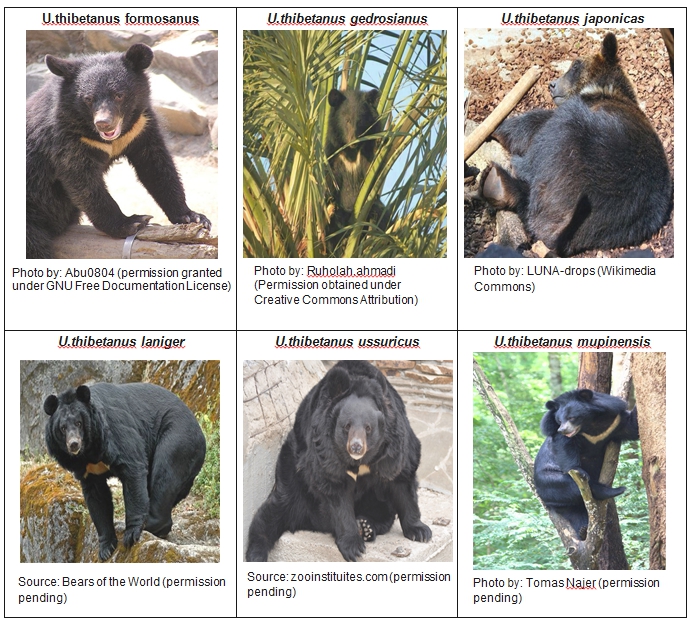
Fig 3. Pictures of all the different sub-species
3. Distribution
Now that we know how to identify an Asian black bear, let us learn about where they are found. U.thibetanus is widely distributed and it can be found north of Pakistan, south of Afghanistan, east of Himalayas, North of Vietnam, south of China, Japan, Korean Peninsulas and Thailand (Fig. 4) Fossil remains have even been found as far west as Germany and France! [3] Its distribution roughly coincides with forest distribution in southern and eastern Asia and has an overlap with the sun bear (Helarctos malayanus) in a large portion of Southeast Asia. Interestingly, it occupies all countries in mainland Southeast Asia except Malaysia which houses the sun bears.

Fig 4. General distribution of the Asiatic black bear (U.thibetanus)
(Source: IUCN http://maps.iucnredlist.org/map.html?id=22824)
No rigorous population estimates exist for this species. However, it is clear that the population is facing a decreasing trend [1].
4. Ecology and behaviour
4.1. Vocalisation
Asiatic black bears have a wide range of vocalisation including grunts, whines, roars, slurping sounds made when feeding, “an appalling row” made when wounded, alarmed or angry. Watch the video below of how a bear searches for her cubs! It also emits loud hisses when issuing warnings or threats and scream when fighting. When approaching other bears, they produce a” tut tut” sound which is believed to be produced by snapping their tongues against the roof of their mouths [1].
June the bear misplaces her cubs. Listen to her produce low frequency grunts as she attempts to find them. Headphones are advised for clearer audio.
Source: www.youtube.com
4.2. Habitat
The Asiatic black bears typically inhabit deciduous forests, deserts, mixed forests and thornbush forests. Exact habitats depend on the geographical region in which they are found. However, with increasing encroachment of human activities such as deforestation, the remaining populations of wild Asiatic black bears are forced into small and isolated pockets of vegetation at higher altitudes [5].
4.3. Hibernation
Asiatic black bears depending on the geographical region they are found. In colder climates, the bears hibernate during the winter months and in warmer climates, they enter a rest period. During a rest period, its body temperature drops slightly and the bears can be easily awoken. During
hibernation, the bears experience a significant drop in heartbeat and body temperature [2]. Like its relatives, it does not excrete urea or solid fecal material during hibernation but instead convert the waste material to proteins.
4.4. Diet and feeding habits
Asiatic black bears are classified as carnivores but it in fact has a widely varied omnivorous diet which includes smaller animals, plants and insects. Asiatic black bears typically feed diurnally or twice a day but increases throughout autumn in preparation for hibernation. However, it also consumes crops and livestocks leading to increased human-animal conflict [1]. When food production and availability is poor, they strip the bark off of trees to supplement their deficient diet [6]. The bears are also thought to be intelligent as they are to be able to shift the feeding cycle according to human activity.
5. Breeding and reproduction
5.1 Courtship
Unfortunately, little is known about the bears in the wild and most information collected is from observations in the zoos. The mating patterns of the bears are described to be prosmicuous [2]. The mating cycle is typically 12 to 25 days. This is where size matters! Larger males have a higher chance of mating than smaller males.
5.2. Reproduction
Asiatic black bears are able to breed starting from 4 to 5 years old and do so during the warmer summer months of June and July.
Gestation period: 6-8 months
Number of offspring: 1-4 cubs with an average of 2
Asiatic Black bear cubs are born hairless and rely heavily on the warmth of their mother. Cubs cannot fully open their eyes until they are at least a week old and they are not fully weaned until they are 3 months old. Cubs live with the mother until they are 2 to 3 years old [7]. Let us enjoy a picture of an adorable cub (Fig 5).
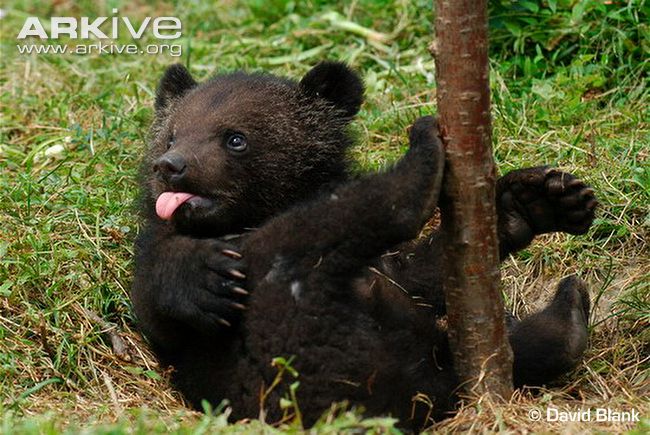
Fig 5. A picture of a playful cub sticking out its tongue (Photo by: David Blank)
Source: www.arkive.org
5.3 Life expectancy
Wild: ~25 years
In captivity: Up to 30 years [5]
6. Conservation

Fig 6. Status of U.thibetanus
Source: IUCN (http://www.iucnredlist.org/details/full/22824/0)
Under the IUCN Red List of Threatened Species, the Asiatic black bear is listed as a Vulnerable species and it is protected by CITES Appendix I (Fig 6). In various countries, there are additional laws to protect this declining species. For instance in China, they are under class of China’s Wildlife Protection Law which stipulates that anyone hunting or catching bears without permits will be subjected to severe punishments. In India, the bears are protected under the Indian Wildlife Act.
6.1. Human-animal conflict
Quoting from Brown, Asiatic black bears are believed to be more aggressive towards humans than the brown bears of Eurasia [8] and this aggression is thought to be an adaptation to being in the same geographic region as tigers. Most recently, a group of bears attacked villages in Orissa killing eight and injuring many more [3].
There is increased interaction between bears and humans especially when the Asiatic black bears are known to depend on livestock as one of its food sources. Of the 1,375 livestock kills examined in Bhutan, black bears account for 8% of attacks [9]. Black bears can also be serious crop predators. This drives humans to hunt them down!
6.2. Threats
6.2.1 Habitat loss
Habitat loss due to logging, expansion of human settlements, roads is the most severe in the southern portion of the range. In India, less than 10% of the species range is within protected areas (PAs) and areas outside PAs are subjected to development projects [1]. Forested areas are becoming increasingly fragmented. The situation seems to be slightly better in China as forested areas are increasing due to mandated government programs, however it remains to be seen if these newly planted forest habitats are suitable for the black bears. Similarly in Japan, the black bear range is believed to have expanded [10].
6.2.2. Animal products
6.2.2.1 Internationally
The next major threat to Asiatic black bears would be the commercial trade in live bears and bear parts most notably bile from their gall bladders. The bile is used in in Traditional Chinese Medicine (TCM) as it is believed to be effective in healing various ailments such as fever, haemorrhoids, conjunctivitis and liver diseases. The ursodeoxycholic acid (UCDA) present in bear bile has been proven to be successful in treating liver problems [11]. To meet demands, China initiated commercial bear farming in 1984. Bile is periodically drained from captive bears and claims to not capture from the wild. However, there is no evidence and there has been international uproar over the welfare of these captive bears. Similarly in Vietnam, many small-scale bile farms exist which were stocked by several thousand bears removed from the wild. As these farms typically do not attempt to breed the bears, they are not sustainable which implies that wild bears are still captured. The number of wild-caught farmed bears in Vietnam is estimated to have increased by an order of magnitude in less than a decade [22]. In addition, with increasing affluence, the market for bear paws appears to be increasing as it is treated as a delicacy.
6.2.2.2 Locally
Bear bile products can also be found in Singapore. In a study conducted by Animal Concerns Research and Education Society (ACRES) in 2001, 68 TCM shops were surveyed and 73% were found to be selling products related to bear bile. They recognised that the Asiatic black bear is a protected species and some claim to have received permits although none has ever been issued legally in Singapore [13]. In 2014, a report by TRAFFIC cited Singapore as a “key international trade route for bear bile products and sustains a well-developed domestic market” [14]. Hence, it is a real problem that requires attention. It is imperative that consumers seek herbal alternatives.
Below are several disturbing videos that are NOT for the faint-hearted! It allows an insight to what a typical bear farm looks like and how the bears go through excruciating pain.
Video to raise awareness and end bear farming by Animals Asia
Guy confronts bear bile farmer about the illegal practice of extracting bear bile
Bile extraction from a hopeless moon bear
6.3 What you can do
There are several organisations that are dedicated to conserving these bears by ending the bear bile trade. Bear sanctuaries operate in China and Vietnam where bears are rescued from the farms are rehabilitated. Alternatively, you could help to spread awareness by joining in campaigns or simply discourage others from consuming products with bear bile such as the older generations. You could also donate for the cause or contribute as a volunteer. Below are some useful links!
https://www.animalsasia.org/intl/get-involved/
https://www.animalsasia.org/intl/get-involved/fundraise.html
.
7. Taxonomy and systematics
7.1. Taxonavigation
For readers that may want to delve deeper!
| Kingdom |
Animalia |
| Phylum |
Chordata |
| Class |
Mammalia |
| Order |
Carnivora |
| Family |
Ursidae |
| Genus |
Ursus |
| Species |
Ursus thibetanus |
| Sub-species |
Ursus thibetanus formosanus (Swinhoe, 1864) Ursus thibetanus gedrosianus (Blandford, 1877) //Ursus thibetanus japonicus// (Schlegel, 1857) //Ursus thibetanus laniger// (Pocock, 1932) //Ursus thibetanus mupinensis// (Heude, 1901) //Ursus thibetanus thibetanus// (G. [Baron] Cuvier, 1823) //Ursus thibetanus ussuricus// (Heude, 1901) |
7.2. Phylogeny
Bear phylogeny has long been a focus of study due its conservation value as all bear genera have been classified as endangered either at species or subspecies level. The Ursidae is a major family that comprises of eight species which can be classified into Ailuorpoda (giant panda), Tremarctos (spectacled bear) and Ursus (broth, polar, sloth, sun, Asiatic and American black bears). It can be said that relationships within the genus Ursus remains an unresolved issue in a bid to find the most valid genetic marker [15]. Figure 7 below shows the complexity of the issue.

Fig 7. On the left is the long-standing unresolved Ursidae phylogeny tree and on the right are competing hypotheses based on different mitochondrial DNA that were used to construct the trees. For example, using mtA, the Asiatic black bear is no longer considered the sister taxa of the American black bear
Thus, the combined data sets of 12 protein-coding genes from 8 complete mitochondrial genomes were analysed to produce a single most-parsimonious tree (Fig 8).
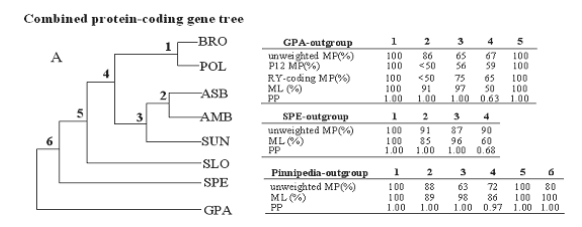
Fig 8. Phylogenetic tree based on combined protein-coding genes. The spectacled bear diverged the earliest, followed by the sloth bear. American black bear and Asiatic black bear are considered sister taxa.
Within U.thibetanus, the evolutionary time estimates for Asian black bear populations are also debatable. It is speculated that the Japanese population or U.thibetanus japonicus are genetically distant from the two continental population which suggested earlier origins. The maximum likelihood tree of eight Asian Black bears inferred from the complete mitochondrial protein genes and rRNAs are shown in Figure 9. U.thibetanus japonicus is recognized as the basal split among the species U.thibetanus, indicating that the Japanese population is not a direct descendant of the extant continental populations.
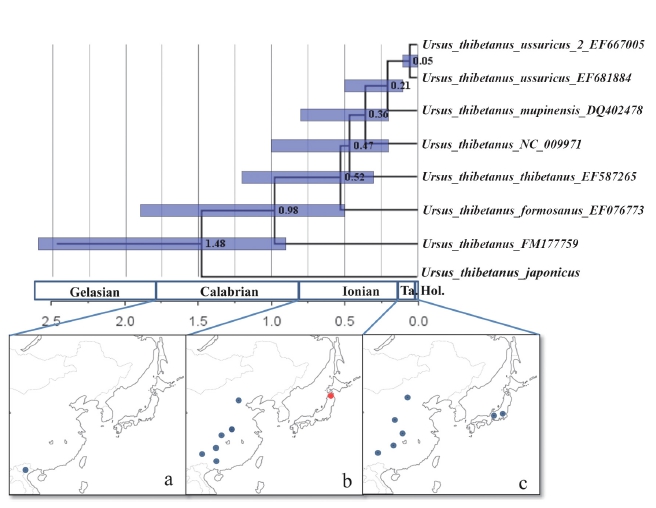
Fig 9. Coalescent times of U.thibetanus.Nodal numbers indicate the estimate coalescent time (Ma) at 95% confidence interval. (a-c) represents the geographical distribution of fossils of Asiatic black bears with (a) the Early Pleistocene (b) the Middle Pleistocene and (c) the Late Pleistocene.
Source: Wu J, Kohno N, Mano S, Fukumoto Y,Tanabe H, Hasegawa M, et al. (2015)
7.3 Molecular Data
There are 11 barcode sequences available from Barcode of Life Data Systems (BOLD) and GenBank.
Click for more information!
8. References
[1] Garshelis, D.L. & Steinmetz, R. (IUCN SSC Bear Specialist Group). 2008. Ursus thibetanus. The IUCN Red List of Threatened Species 2008: e.T22824A9391633.http://dx.doi.org/10.2305/IUCN.UK.2008.RLTS.T22824A9391633.en . Downloaded on 11 November 2015.
[2] Goodness, T. 2004. "Ursus thibetanus" (On-line), Animal Diversity Web. Accessed via http://animaldiversity.org/accounts/Ursus_thibetanus/ on 11 November 2015
[3] Servheen, C., Herrero, S., & Peyton, B. 1999. Bears: Status Survey and Conservation Action Plan. IUCN, Gland
[4] Hays, J. (2008). BEAR SPECIES IN ASIA: SUN BEARS AND MOON BEARS. Accessed via http://factsanddetails.com/asian/cat68/sub433/item2453.html on 11 November 2015
[5] Asiatic Black Bear. (n.d.). Accessed via http://a-z-animals.com/animals/asian-black-bear/ on 11 November 2015
[6] Hayashi, S., Y. Yoshida, M. Horiuchi, T. Tsubota, T. Murase, T, Okano, M. Sato, K. Yamamoto. 2002. Analysis of causes of bark stripping by the Japanese black bear (Ursus thibetanus japonicus). Honyurui Kagaku, 42(1): 35-43
[7] Nowak, R. 1991. Walker’s Mammals of the World, Fifth Edition. Baltimore and London: Johns Hopkins University Press.
[8] Brown, G. 1993. Bear Anatomy and Physiology from The Great Bear Almanac, Lyons & Burford, Publishers.
[9]Sangay, Tiger; Vernes, Karl. 2008."Human-wildlife conflict in the Kingdom of Bhutan: Patterns of livestock predation by large mammalian carnivores" (PDF).Biological Conservation141(5): 1272. doi:10.1016/j.biocon.2008.02.027
[10] Oi, T., & K. Yamazaki. 2006. The status of Asiatic black bears in Japan. 122–133 in Japan Bear Network, editors. Understanding Asian bears to secure their future. Japan Bear Network, Gifu, Japan
[11] Achord, J.L. 1990. Is Oriental folk use of bear bile vindicated (yet)? Gastroenterology 98:4:1090-91
